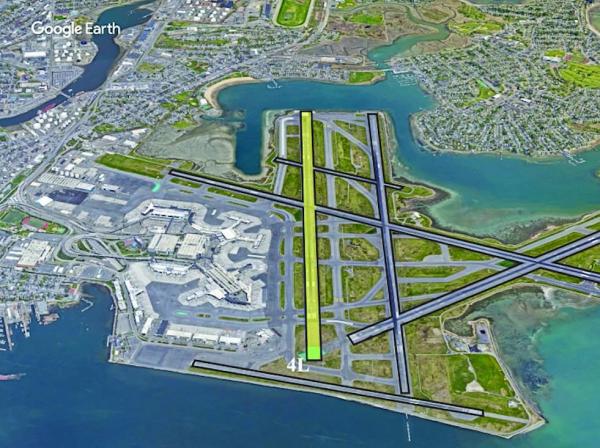November 5, 2020

A aerial view of Logan Airport shows Runway 4L labeled in the middle of the complex. The Federal Aviation Administration is reviewing a proposal that would shift more aircraft over Dorchester and Milton to land on the runway during poor weather. FAA image
The Federal Aviation Administration (FAA) held two virtual public workshops last week during which officials shared the findings of an environmental review for a proposed new flight approach to Runway 4 Left (4L) at Boston Logan Airport that they said show the proposed flight path would not result in any substantial environmental or noise impacts while enhancing safety and efficiency at the airport.
Residents who live under the flight path, which sits over parts of Dorchester and Milton, expressed concerns that noise pollution would get worse with a bigger flight load overhead.
Officials said a new Instrument Approach Procedure (IAP), would use GPS-enabled navigation for aircraft approaching the runway which, they said, will provide for a more efficient operation in poor weather.
The flight path enters Logan space from the southwest, and the IAP would provide pilots and traffic controllers with lateral and vertical electronic guidance as planes approach the runway, which in turn will make for a more predictable, consistent and stable landings.
Doug Willey, a pilot and member of Air Line Pilots Association, explained to about 180 people in the virtual workshop how the proposal would be beneficial to pilots.
“Currently Runway 4L is a visual-approach-only runway, and this particular procedure would mean that there would be an instrument approach,” he said. “Visual approaches are perfectly safe and we do them all the time, but any time we can get more information and data in the flight deck to help us back up the procedures that we do, it’s an improvement.”
One resident asked the FAA team if they “used noise monitors out in the neighborhoods?”
Donovan Johnson, the project’s technical lead, answered that “to calculate the impacts of this proposed procedure we are required to use noise modeling as opposed to direct noise measurements on the ground. That allows the FAA to estimate noise levels over a wide geographic area.
“Noise measurements, on the other hand, would only allow targeted measurements which is not practical for an air traffic project of this type.”
Another attendee asked what exactly is meant by “bad weather?” and Willey took up the question:
“To describe weather, we usually say we have high ceilings or high visibility or we have marginal conditions. … Marginal conditions are anything that affects our visibility and the ceiling of the clouds,” he said.
“So if you are standing on the ground and you look up and can measure how high the cloud deck is, that’s what we would call a ceiling. We’re talking about rain, mist, fogs, low clouds, freezing fog, snow, basically anything that affects our ability to see the runway or land the aircraft safely.”
The FAA projects that if the changes are implemented, 359 aircraft would use the procedure each year. The makeup of that number would consist of 104 flights reallocated from other arrival runways and 255 landings that would be enabled by additional airport efficiency from the new procedure.
Logan currently has six runways, with two pairs of parallel paths that range from 2,500 to more than 10,000 feet in length. The airport can accommodate around 120 takeoffs and landings per hour in good weather conditions, and 60 during inclement weather. A total of 427,176 aircraft took off and landed there in 2019.
The public comment period for the proposed plan will close on Nov. 20. Comments on the draft must be submitted on the project page at faabostonworkshops.com/project-information/ea-findings by sending an email to FAABostonWorkshops@esassoc.com.
A letter may be sent to Environmental Science Associates, c\o Boston Logan RNAV (GPS) Approach EA, 4200 West Cypress St, Suite 450, Tampa, FL 33607.



